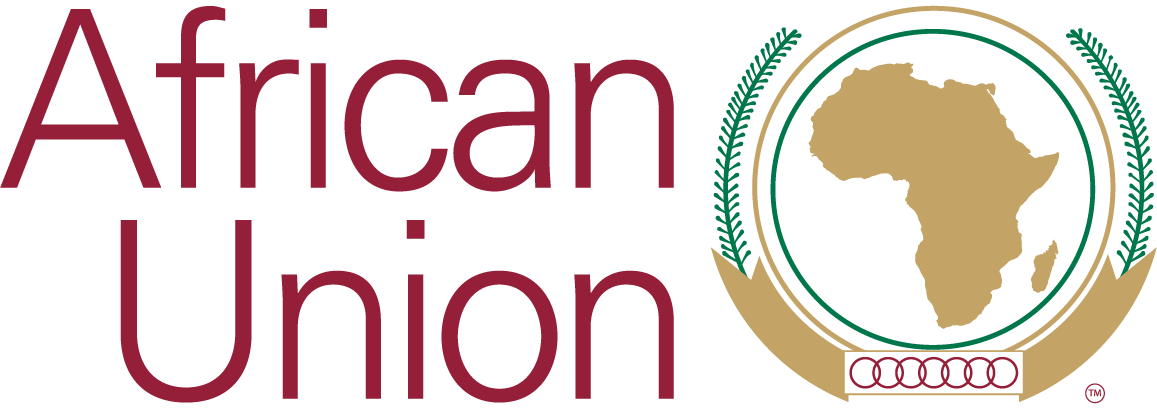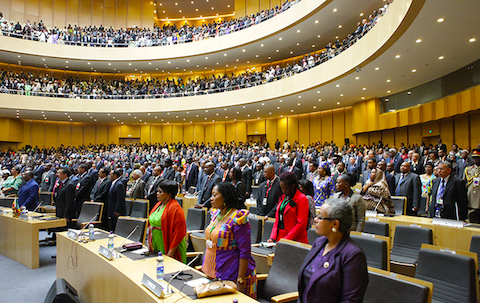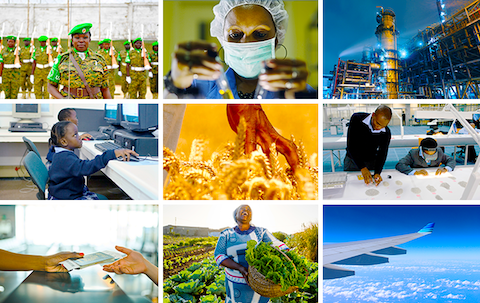Topic Resources
2014 Year of Agriculture and Food Security in Africa, Marking 10th Anniversary of CAADP
Theme:
“Transforming Africa’s Agriculture for Shared Prosperity and Improved Livelihoods, through Harnessing Opportunities for Inclusive Growth and Sustainable Development ”
Concept Note
1. Introduction
The African Union Assembly of Heads of State and Government, during its 19th Ordinary Session, held from 15-16 July 2012 in Addis Ababa, Ethiopia, declared the year 2014 to be the Year of Agriculture and Food Security in Africa, marking 10th Anniversary of the adoption of the Comprehensive Africa Agriculture Development Programme (CAADP).
Over the last decade, through the instrumentality of CAADP, African agriculture and food security concerns remain high on the policy agenda at national, regional, continental and global levels. Thanks to such concerted actions, the performance of African agriculture has been encouraging – with annual agricultural GDP growth having averaged nearly 4 per cent since 2003 – well above the agricultural GDP growth rates for the previous several decades. It is absolutely necessary to sustain the momentum of such a positive change and development taking place in Africa well into the next decade. The AU Decision declaring 2014 to be the Year of Agriculture and Food Security in Africa, and marking 10th Anniversary of CAADP, is an important milestone and an opportunity that should be seized in the resolve to continue to uphold agriculture and food security as priority for policy and practical actions to generate concrete results and impacts.
True to its name, the African Year of Agriculture and Food Security will be commemorated across Africa, in Member States, Regional Economic Communities, Continental organisations, and of course at the AU Headquarters in Addis Ababa, Ethiopia. It will be a year that gives opportunities to communities, state and non-state actors in Africa to interact, express their voices on what works and chart the focus and targets for the next decade. The process will facilitate for this voices to contribute towards setting the agenda for sustaining the CAADP momentum which forms the basis for African leaders to recommit themselves towards realizing the vision set out in 2003.
It is also remarkable that the African Year of Agriculture and Food Security is to be commemorated in 2014 following, and overlapping with at least for the first half of the year, the continued celebrations of the 50th Anniversary of the OAU/AU, particularly at a time when the thrust of the African Union Agenda 2063: “A Shared Strategic Framework for Inclusive Growth and Sustainable Development” is being deliberated. Truly, the agenda of agricultural transformation is strategically positioned to provide enormous opportunities for an inclusive and sustainable development in Africa.
This concept note is intended to provide general information on how 2014 the Year of Agriculture and Food Security, marking 10th Anniversary of CAADP, is envisaged to be commemorated. It briefly presents the proposed theme and sub-themes around which the various events are going to be organized, which will be followed by an outline of the actions and events that will guide the activities outlined. Finally, the different structures and mechanisms that are proposed to steer and manage the process to fruition are defined.
2. Background and rationale
Africa has recognised that enhanced agricultural performance is key to growth and poverty reduction through its direct impact on job creation and increasing opportunities, especially for women and for the youth; on food security and improved nutrition; and on building resilience. This is due to both the heavy weight of agriculture in African economies and livelihoods, and the strong linkages that agriculture forges with other sectors.
In 2003, the AU Assembly of Heads of State and Government adopted the Maputo Declaration on CAADP setting broad targets of 6% annual growth in agricultural GDP, and allocation of at least 10% of public expenditures to the agricultural sector. The leaders signalled their intentions to achieve these targets through collective actions across the continent focused on improving agricultural planning and policies, scaling up investment to implement these plans and policies, and harmonising external support around African-owned plans.
A decade of CAADP experience has demonstrated that Africa as a region has a well-crafted, home-grown framework guiding policies, strategies and actions for agricultural development and transformation; which has been instrumental in raising the profile of agriculture at the centre of development agenda at national, regional and global levels; which has also facilitated mobilization and alignment of multi-stakeholders partnerships and investments around national agriculture and food security investment plans that have been developed through the CAADP process.
CAADP has also encouraged and facilitated for evidence based planning, and commitment to institutional and policy reforms with a sense of mutual accountability for actions and results, as well as for demonstrated African ownership, and for active engagement of partnerships of multi-stakeholders. Mechanisms such as agricultural sector reviews at country level, and annual CAADP Partnership Platforms are increasingly being used as review and dialogue platforms in fostering accountability for results on agriculture performance.
It is significant to note that to date 34 AU Member States have signed CAADP compacts; 30 among them have developed formal national agriculture and food security investment plans – and these have become their medium term expenditure frameworks for agriculture, thus resulting in improved agricultural planning. At regional level, four (4) out of eight RECs have also signed Regional compacts out of which three have developed fully costed investment plans. On average public agricultural expenditures have risen by over 7 per cent per year across Africa since 2003, nearly doubling public agricultural expenditures since the launch of CAADP .
Obviously demand for more clarity has been expressed in terms of further elaboration and refinement of the CAADP targets, and assessment of technical efficacies and political feasibilities for success as well as identifying key factors that define success in agricultural transformation. The AU Commission and NPCA have recently commissioned studies to try and provide some answers to these vexed questions. The outcomes of the studies are expected to provide an important input into the series of deliberations and mutual learning and experience sharing opportunities planned during the Year of Agriculture and Food Security in Africa, marking 10th Anniversary of CAADP.
In terms of performance, annual agricultural GDP growth has averaged nearly 4% since 2003 – well above the agricultural GDP growth rates for the previous several decades. Several Member States have also achieved significant improvements in tackling the challenges of hunger, undernourishment and extreme poverty. It is important to note that in most African countries, it is the improvement of agricultural performance that can contribute towards the achievement of pro-poor growth. Empirical evidences suggest that a 1% gain in GDP originating from agriculture generates a 6% increase in oval all expenditure of the poorest 10% of the population; in contrast a 1% gain in GDP originating from non-agricultural sectors creates zero growth.
These experiences are strong indicators that inclusive growth as advocated under CAADP is a process requiring sustained and concerted actions and efforts in application of quality policies, strategies, programmes, and investments driven by strong political commitment and leadership and fostering effective partnerships. It is therefore, desirable that the next decade will build on this momentum to deliver in an accelerated manner, positive changes towards prosperity that directly impacts on livelihoods of African citizens through an inclusive agricultural transformation process.
3. Objectives and expected outcomes
3.1. Objectives
i. To facilitate broad-based and inclusive consultations, and dialogue among all relevant stakeholders (parliamentarians, women groups, youth groups, farmers organisations, CSOs, private sector, etc.) on African Agriculture and food and nutrition security,
ii. To facilitate mutual learning and experience sharing among countries with a view to strengthening and deepening country engagements and ownership to advance the agriculture and food security agenda.
iii. To facilitate high level political dialogue on collective actions and seek demonstrable commitment by the Heads of State and Government for a sustained support and engagement on agriculture through the CAADP framework.
iv. Facilitate dialogue with Africa’s strategic partners – for demonstrable commitment to programme alignment, harmonization, coordination and mutual accountability for results.
3.2. Expected Outcomes
(i) Enhanced level of awareness and engagement among broad spectrum of African citizenry (legislators, farmers organisations, CSOs, women and youth groups, private sector, etc.)
(ii) Improved platforms for multi-sectoral actions at country and regional levels.
(iii) Renewed demonstrable political commitment by African leaders through adoption of an AU Declaration to sustain the momentum to deliver on a set of measurable goals and targets.
(iv) Renewed demonstrable commitment by Africa’s partners to alignment, harmonization and coordination of programmes and support and to mutual accountability for results.
4. Theme and sub-themes
The proposed theme for 2014 Year of Agriculture and Food Security, Marking 10th Anniversary of CAADP is:
“Transforming Africa’s Agriculture for Shared Prosperity and Improved Livelihoods, through harnessing opportunities for inclusive growth and sustainable development”.
There is now broad consensus that without a successful agricultural transformation, neither could agricultural growth be sustained nor would its impact on prosperity and poverty reduction be ensured.
The goal of agricultural transformation in Africa, first and foremost is to enable production and availability of food for the population, and provide livelihoods to those involved, raise income, create jobs and wealth of those involved in the sector and along the entire value chain. But it is also functional to the attainment of other macroeconomic objectives through its forward and backward linkages with the other sectors. African agriculture needs a major transformation if it has to significantly contribute towards the improvement of livelihoods of the population as well as to the broader countries macroeconomic welfare and prosperity.
As is known, African agriculture is predominantly smallholder agriculture – the majority of which is organized by women farmers; hence, unavoidably should be at the centre of the transformation agenda. Moreover, due to demographic dynamics, the future farmers in Africa are going to be younger, but also they are going to be better exposed to new technologies and ideas, better informed, and with growing needs and aspirations. The issue of motivating the youth to see their future in a growing and transforming agriculture and rural economy presents a real challenge. Therefore, the sooner these considerations are factored in the transformation agenda the better.
Pursuing such critical considerations in a consistent manner, which have hitherto been customarily neglected in policies, strategies and public actions, is nothing but to embrace an inclusive process of growth and sustainable development; and there are clear opportunities if seized can help realize this goal. Some of these opportunities include: (a) the fact that currently agriculture has been high on the agenda at national, regional and global levels, (b) the growing focus on agricultural value-chain development and enhancing the profile of local enterpreneurs, (c) ease of accessibility and wide use of ICT in rural and urban areas, and (d) Africa’s huge untapped productive resources (land, water, human capital, among others).
Therefore the theme is intended to capture these key messages of transformation, impacts, inclusiveness and opportunities.
4.1. Sub-themes
Agricultural transformation and sustained inclusive agriculture growth for shared prosperity and improved lives and livelihoods, as a key plank of Africa socio economic development strategies in the next decade must address the following, which will serve as sub-themes:
(i). Increased agriculture production, productivity and value addition
(ii). Functioning agricultural markets (country and regional markets & trade)
(iii). Increased investment financing (public & private) along the agriculture value chains
(iv). Towards ending hunger in Africa by 2025
(v). Building resilience to address vulnerability to risks
5. Major activities and events
It is anticipated that a series of events and activities are going to be organised throughout the year by various stakeholders at national, regional and continental levels. It is therefore necessary to provide guidance and coordinate these efforts.
During the first half of the year, efforts will mainly be focussed on articulation of the key messages through a process of stakeholders’ consultations, in particular RECs and Member States, and deepening engagement for high level political commitment.
At the continental level, the main events planned for the first half of the year, in the run up to the July 2014 AU Summit include:
i. Launch of 2014 Year of Agriculture and Food Security in Africa, marking 10th Anniversary of CAADP, during the January 2014 AU Summit in Addis Ababa, Ethiopia-
ii. The 10th CAADP Partnership Platform Meeting to be held from 19th – 24th March, 2014 in Durban South Africa – organised by AUC and NPCA, which brings together Member States, RECs, key African Institutions and partners to review progress, and synthesise lessons for way forward.
iii. The Joint AU Conference of Ministers responsible for Agriculture, Fisheries and Aquaculture, and Rural Development, to be held from 28th April – 2nd May, 2014 also in Durban South Africa – which will deliberate on the theme and sub-themes and make resolutions for consideration by the AU Policy organs.
iv. The African Agribusiness Forum planned for June 2014 in Addis Ababa – which among others is expected to explore business opportunities for African entrepreneurs particularly women and youth, in the context of agricultural transformation and inclusive growth; and
v. The July 2014 AU Summit, whose theme will focus on the Year of Agriculture and Food Security in Africa and commemoration of CAADP at 10 - where discussions and deliberations will be dedicated to agriculture, food and nutrition security– and a declaration on “agricultural transformation and inclusive growth for shared prosperity and improved livelihoods” is sought.
An effective advocacy and communication campaign will be launched throughout the year targeting a broad spectrum of audiences. Relevant events that will be co-organised with partners shall be used as important platforms for advocacy, communication and fostering partnerships.
At regional level, RECs are encouraged to take lead to organise events on the theme. Countries will be sensitised and facilitated to organise events on 2014 Year of Agriculture and Food Security. In addition, forums and organisations with stakeholders representation (women groups, youth groups, farmers organisations, etc.) will be encouraged and facilitated to organise events relevant to their respective concerns.
In shaping the key events leading to the July Summit and mainly towards and during the CAADP PP and Joint Conference of Ministers responsible for Agriculture, Ministers of Fisheries and those of Rural Infrastructure, the engagements and discussions will be guided along the areas of broader thematic areas .
At the launch during the January 2014 Summit, guidelines will be presented for Member States and RECs to engage in extensive in-country and regional consultations to facilitate effective dialogue with all stakeholders.
Launch of 2014 Year of Agriculture and Food Security in Africa, marking 10th Anniversary of CAADP.
It is befitting that the 2014 Year of Agriculture and Food Security in Africa, marking 10th Anniversary of CAADP, is formally launched during the Assembly session of the January 2014 AU Summit in Addis Ababa, Ethiopia.
The purpose of the proposed launch is to sensitise all stakeholders, in particular Member States and RECs, and provide update on the roadmap for the commemoration, and seek further guidance from Heads of State and Government on way forward.
In addition, a dinner event hosted by the AU Commission on 29th January 2014 in which all African Heads of State and Government, Executives of RECs, Heads of development partners will be invited, will provide opportunity for an interactive of session and interventions from Heads of State and Government on the significance of the theme will be solicited.
Dates:
Jan.15.2014
Agenda 2063 is Africa’s development blueprint to achieve inclusive and sustainable socio-economic development over a 50-year period.









